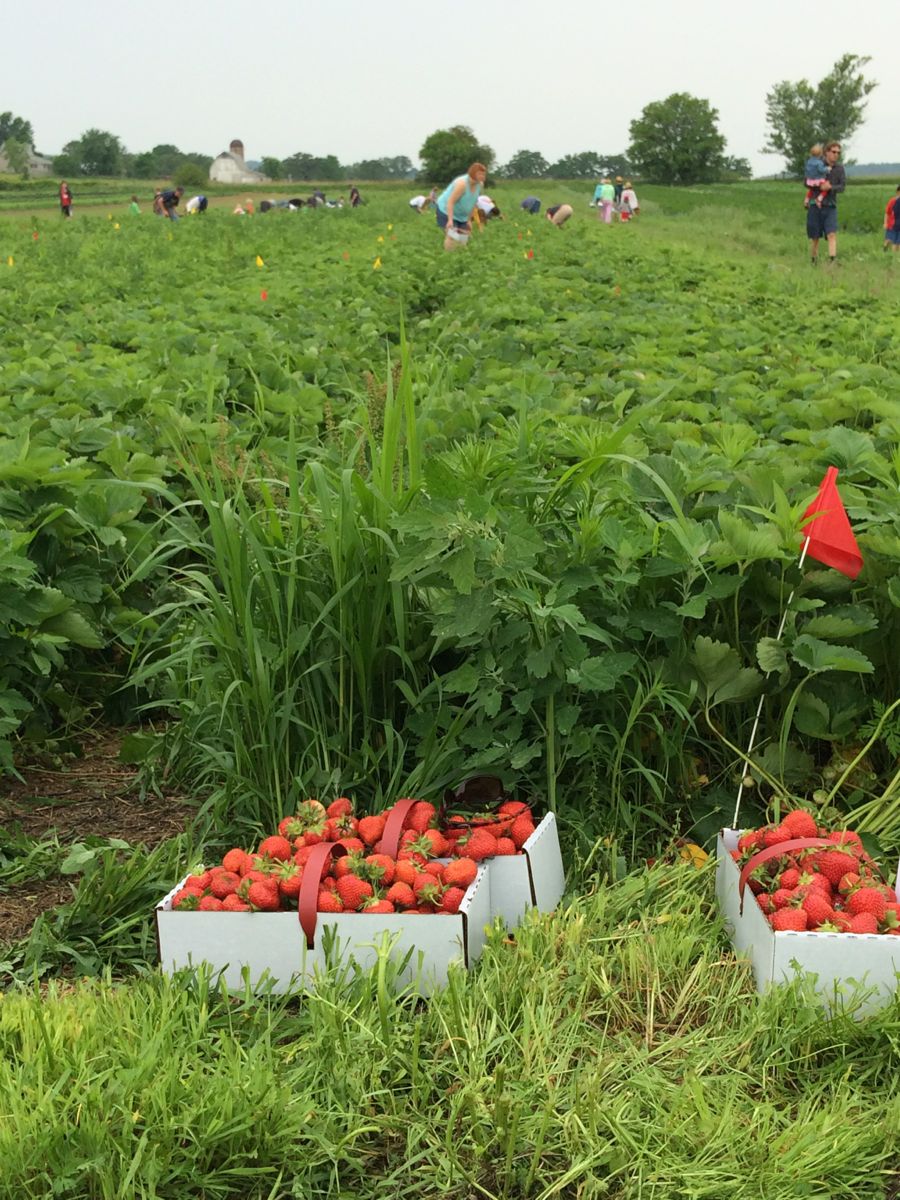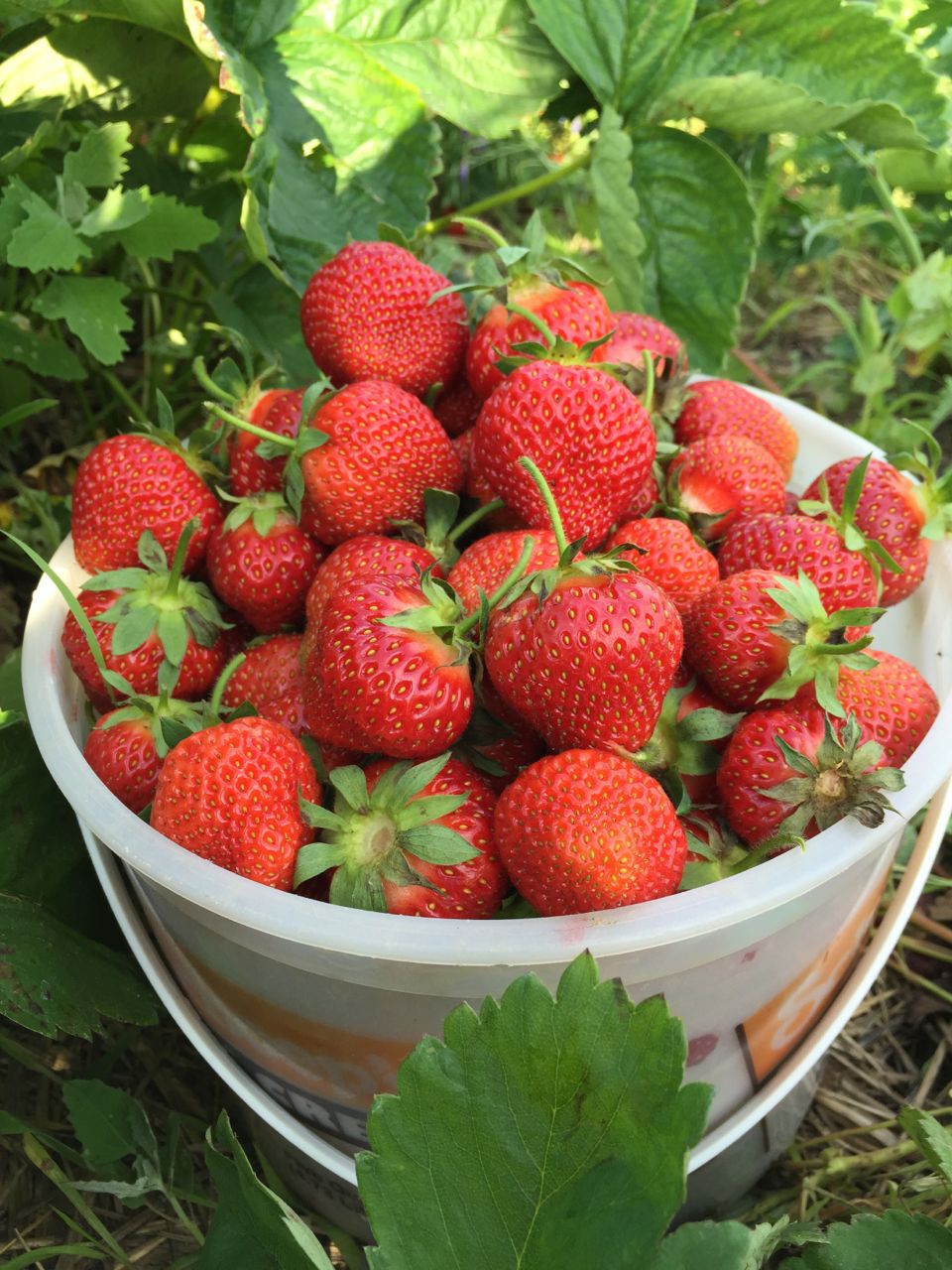Monthly Archives: June 2015
Lucky U-Pick
- On: June 24, 2015
 1
1
We had great conditions for our strawberry u-pick last weekend. The weather stayed dry despite storms in the area, and the picking was easy.
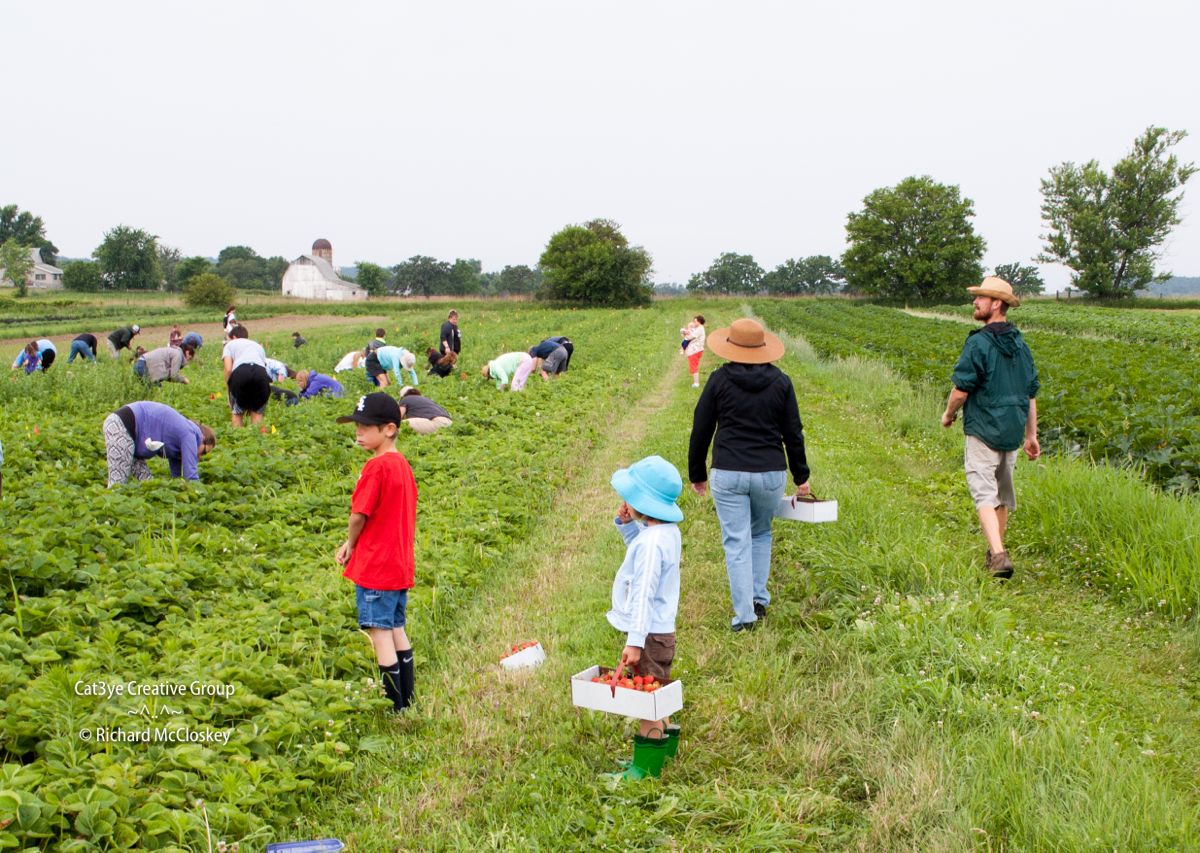
Billy (at right in green jacket) leads members to the berry patch.

Happy members with their berries.
Upcoming final strawberry u-pick
Read our June 24 email for info about the final berry u-pick.
Veggie List and Veggie Notes (June 25/26 2015, week #6, green EOW)
This box is designed for Asian salads or stir-fries, with napa cabbage, daikon, peas, scallions and garlic scapes.
Strawberries, 2 qt
Snap peas, 0.90 lb
Snow peas, 0.25 lb
(Both types of peas are in one bag.)
Napa cabbage
Daikon radish, 1 – 3 by size
Scallions, 1 bunch
Zucchini/summer squash, about 3 lb
Garlic scapes, a handful
Next week’s box will probably contain snap peas, garlic scapes, lettuce, Swiss chard, zucchini, broccoli and more. We’re not sure yet if there will be more strawberries.
Strawberries – Everyone gets two quarts again this week. Strawberries are perishable so don’t try to store these for long. Refrigerate. Compare the two containers, judge which berries are softer and more ripe, and eat those first.
Napa cabbage (large, pale green cabbage with crinkled leaves) – This is an interesting vegetable, useful for both fresh, raw salads and for cooking. These napa are large enough to split among several recipes. Napa’s most famous use is fermented kimchi. I like to prepare a fresh, unfermented kimchi. Same seasonings, but it’s ready to eat right away. You will be amazed at how much shredded napa cabbage shrinks when prepared this way. See here for an example, but cut the salt in half: Grilled Flank Steak with Kimchi-style Coleslaw.
Storage: Napa stores very well. Cut off wedges as needed and keep the rest covered and refrigerated, and it will keep for several weeks. Peel off the outer layer and it will be ready to use. Here are a few preparation ideas from the ‘Asparagus to Zucchini’ cookbook.
– Chop raw napa into green salads.
– Substitute napa in traditional coleslaw.
– Chinese cabbage cooks quickly. Steam 3-5 minutes, or until leaves are wilted down but remain slightly crisp.
– Substitute napa cabbage for common cabbage in recipes, but reduce the cooking time by 2 minutes.
– Napa cabbage is the main ingredient in egg rolls. Try making an egg roll mixture to eat as a cooked side dish instead of preparing time-consuming egg rolls.
Daikon radish (slender white roots) – These Asian radishes are good cooked or raw. We often make a sliced radish salad, with Asian-style dressing (rice vinegar, mirin, sesame oil, soy sauce, minced garlic). Even a brief marination mellows the radish’s sharpness.
Garlic scapes (curly green things) – Garlic scapes grow at the top of garlic plants. They look like flower buds but are actually clusters of tiny bulblets. We snap off the young scapes to direct the plants’ energy into forming garlic bulbs underground. Use scapes as a substitute for garlic cloves. They can be minced, mixed with olive oil, and added to stir fries or simple pasta dishes. The scapes can be sautéed, but will not brown like garlic cloves. Expect them to retain their crunch even when cooked, and to be milder than garlic cloves, closer in pungency to the green garlic we’ve sent. Most of this week’s scapes are from John Hendrickson of Stone Circle Farm who grows organic garlic for our CSA, but some are from our garlic field.
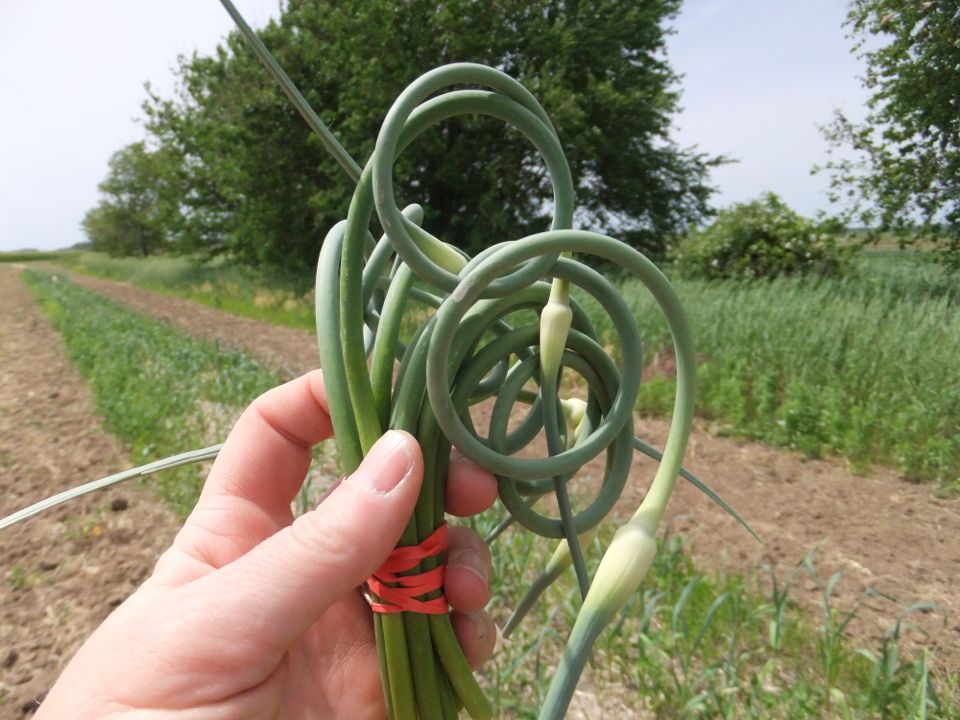
Garlic scapes
THIS WEEK’S RECIPES
Comforting Classics
Strawberry Shortbread with Whipped Cream
Smoked Trout Snap Pea Pasta Salad
Napa Cabbage with Coriander Butter
Napa Cabbage with Cannelini Bean and Kielbasa Sauté
Daikon Pickle
Chocolate Chip Zucchini Muffin
Outside the Box Recipes
Fresh Strawberry Daiquiri
Vegetarian Japanese Snap Pea and Napa Cabbage Soup
Singapore Curried Noodles with Napa Cabbage and Tofu
Kimchi-Style Sautéed Cabbage
Skillet Daikon Radish Fritters
Garlicky Thai Fried Rice with Snap Peas and Summer Squash
Kitchen Sink Recipe
Feel free to serve this over the sautéed napa cabbage or if you like your burger on a bun, tuck in some of the daikon pickles.
Turkey and Zucchini Burgers with Green Onion and Cumin
Quick and Easy Dinner Idea
Grilled Flatbread with Grilled Zucchini or Summer Squash and Snap Pea Puree
Strawberry weeks
- On: June 17, 2015
 2
2
This promises to be our best-ever strawberry crop. Eat ’em, pick ’em, this is the moment. Tipi members, read our June 17 email about two upcoming u-picks.
Strawberry season is a demanding time of year. Peas and strawberries are ready to harvest and both are time-consuming to pick. At the same time, we’re still planting and transplanting crops, yet earlier plantings need weeding. This happens every year. We’re all pitching in and working long hours as needed. The extra effort is worth it; the food this time of year is so delicious and the season so short!
Ginger
We doubled our ginger planting this year. Our small inaugural crop last year was a success. I ordered twice the amount of ginger ‘seed’ this year, an accomplishment as the seed is always in short supply. We buy from a farm in Hawaii that produces disease-free organic ginger seed. They are the only source worldwide right now, so we rarely receive the entire amount we order. I placed my order this winter minutes after they opened sales. The ‘seeds’ are just pieces of gingerroot which we plant in potting mix and keep warm until they sprout. It takes at least 6 weeks before they are ready to plant in the ground in our smallest greenhouse. It’s a great use for an under-utilized corner of the farm. We use this greenhouse for just a month in spring to harden off seedlings before they go outside. After that, it sits empty. Now we have a new use for it. We’ll give you an update in October – that’s when the ginger will be ready to harvest.
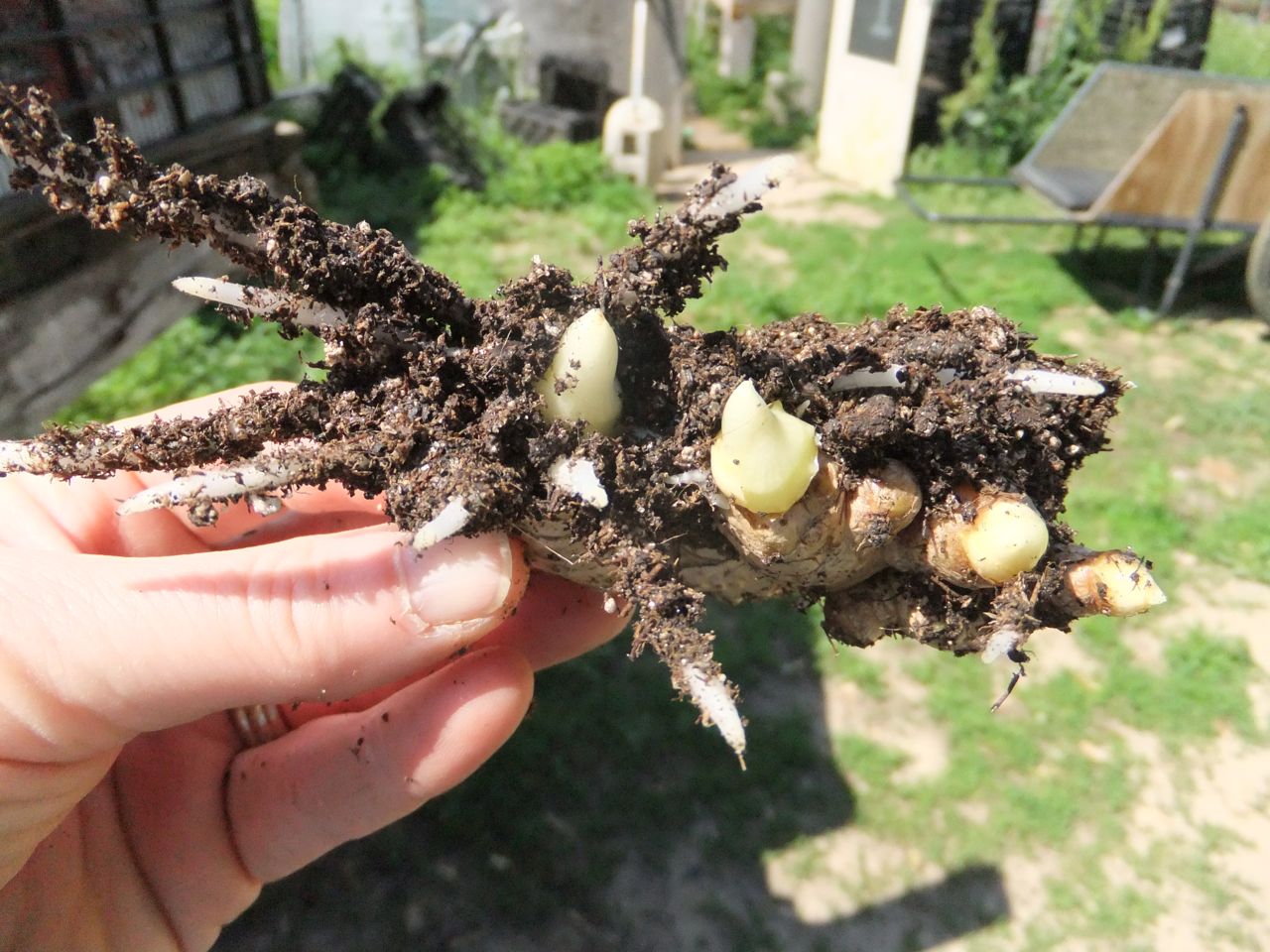
It’s important to pre-sprout gingerroot to get a jump-start on the long growing season needed to produce a crop. Planted into potting mix and kept warm, the gingerroot slowly forms buds and roots.
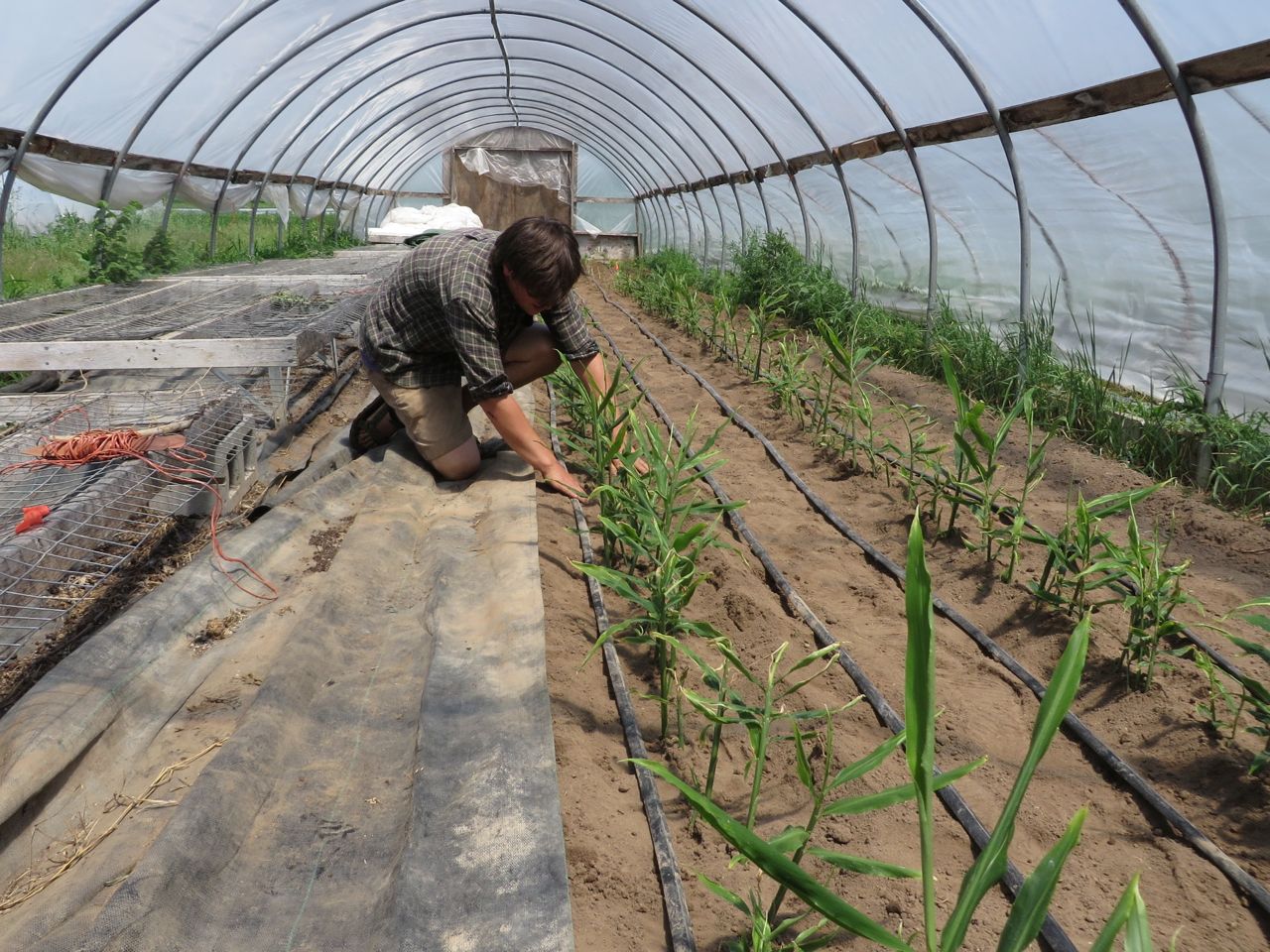
Jory tends young ginger planted in our smallest greenhouse.
Veggie List and Veggie Notes (June 18/19, week #5, purple EOW)
Strawberries, 2+ qt
Asparagus, 0.9 lb
Spinach, 1 bunch
Snap peas, 1.4 lb
Snow peas, 0.25 lb
Both types of peas are in one bag.
Broccoli, 1 medium head
Red bibb lettuce, 1 or 2
Zucchini/summer squash, about 2 lb
Scallions, 1 bunch
Next week’s box will probably contain strawberries, peas, zucchini and summer squash, scallions, garlic scapes and more delightful spring vegetables.
Strawberries! – We’ve been waiting for these.
♦ Ripe strawberries are always perishable but these are especially delicate because of rainy weather earlier this week. Ripe berries should be eaten immediately, or stored in the refrigerator. Most berries are quite clean. If you want to clean your berries, rinse gently. Don’t soak them, just rinse. Do not be concerned if you receive a partially-filled container. Sometimes we fill them partially in order to distribute berries to all the members.
♦ You will receive two or three containers of strawberries. Compare the containers, judge which berries are softer and more ripe, and eat those first.
♦ Please recycle your strawberry containers. We no longer collect them for re-use. Please don’t return them to your pick-up site.
Snap peas (plump pea pods) – These peas should be eaten pod and all. They are delicious raw, or very lightly cooked or stir-fried. They might need a quick rinse to remove faded gray blossoms. Store in the refrigerator. Here’s how to remove the strings from the snap peas. Snap off the stem end and pull the string down the concave side of the pod (the inward-curing side). Throw away the string and eat the pod.
Snow peas (flat pea pods) – These are excellent stir fried or in raw salads. The thicker pea pods will usually have two strings along the edges. Remove them when you snap the stem off.
Zucchini and summer squash – You will receive yellow summer squash or green zucchini. Some squash are oddly shaped but are fine to eat. This is typical for the first picking, and reflects that the first squash were not completely pollinated. The plants were hidden under row covers where pollinators couldn’t find them. The honeybees settled down to work once we removed the row covers. The young squash sizing up for the next picking look great.
THIS WEEK’S RECIPES
Comforting Classics
Broccoli Penne with Spinach Pesto
Salad with Roasted Asparagus, Hard Boiled Eggs, and Chickpeas
Precious Snap Pea Sauté
Strawberry Dessert Pizza
Shaved Zucchini Salad with Parmesan Dressing
Curried Steak, Radish, Zucchini and Snap Pea Stir Fry on Lettuce
Outside the Box Recipes
Sesame Wilted Spinach
Prosciutto Wrapped Grilled Asparagus with Fig Coulis
Quinoa Salad with Snap Peas
Strawberry Soup
Zucchini and Sugar Snap Pea Vietnamese Salad
Lettuce Pesto
Kitchen Sink Recipe
Some of our members like to make a big vat of something that uses up a lot of their veggies, then eat it all week — With this one, you can add just about any of the veggies in your box.
Quick and Easy Dinner
Spice Rubbed Zucchini Tacos with Scallions and Grilled Chicken
Always thinking
- On: June 10, 2015
 0
0
Fortunately for us, Steve loves tinkering with machinery. This week’s inspired idea? He tracked down parts to adapt our old strawberry planter to plant sweet potatoes. Steve bought the berry planter at a farm auction years ago. We haul it out of storage to plant strawberries – that’s all it’s been used for. Adapted with new sprockets to change the spacing, it worked perfectly to plant sweet potato slips.
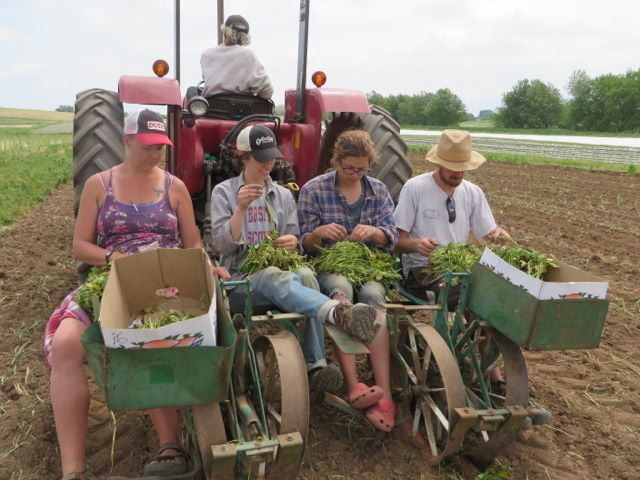
It’s a cozy garden party on the back of the berry planter. From left, Madeleine, Lizzy, Kelcie and Billy place sweet potato slips. Steve drives the tractor.
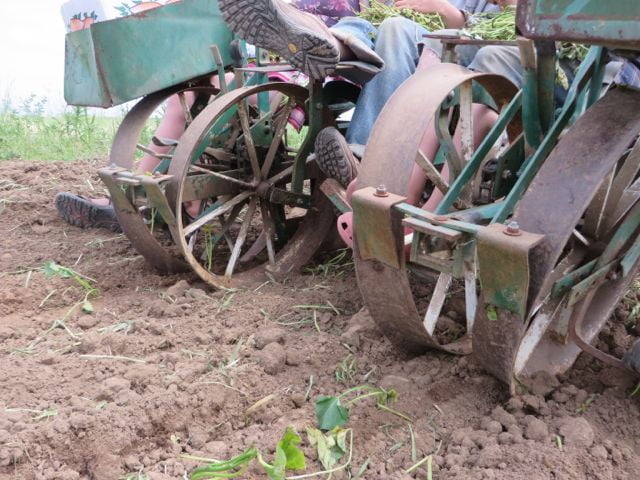
Rusty but reliable, the planter gets the job done.

This small team finished the sweet potato field in one hour. Compare with last years effort …
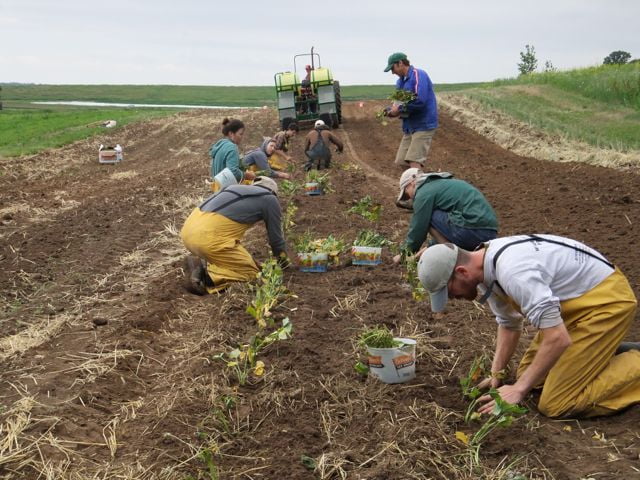
… which took nine people four hours, and was a more difficult, physical job.
Grilled Asparagus
Farming is unpredictable. There are two farm innovations in this story, one successful, one not. Steve had a new idea for the asparagus field this spring. As usual, he mowed down last year’s foliage in April, then shallowly tilled the field to kill off emerging weeds. Just before the asparagus emerged in late April, Steve tilled the field a second time. He’s never done this second tilling, but we have a new tiller with excellent depth control, so it seemed a good step to keep ahead of the weeds. Bad idea! The second tilling brought up a huge flush of ragweed, a particularly aggressive weed.
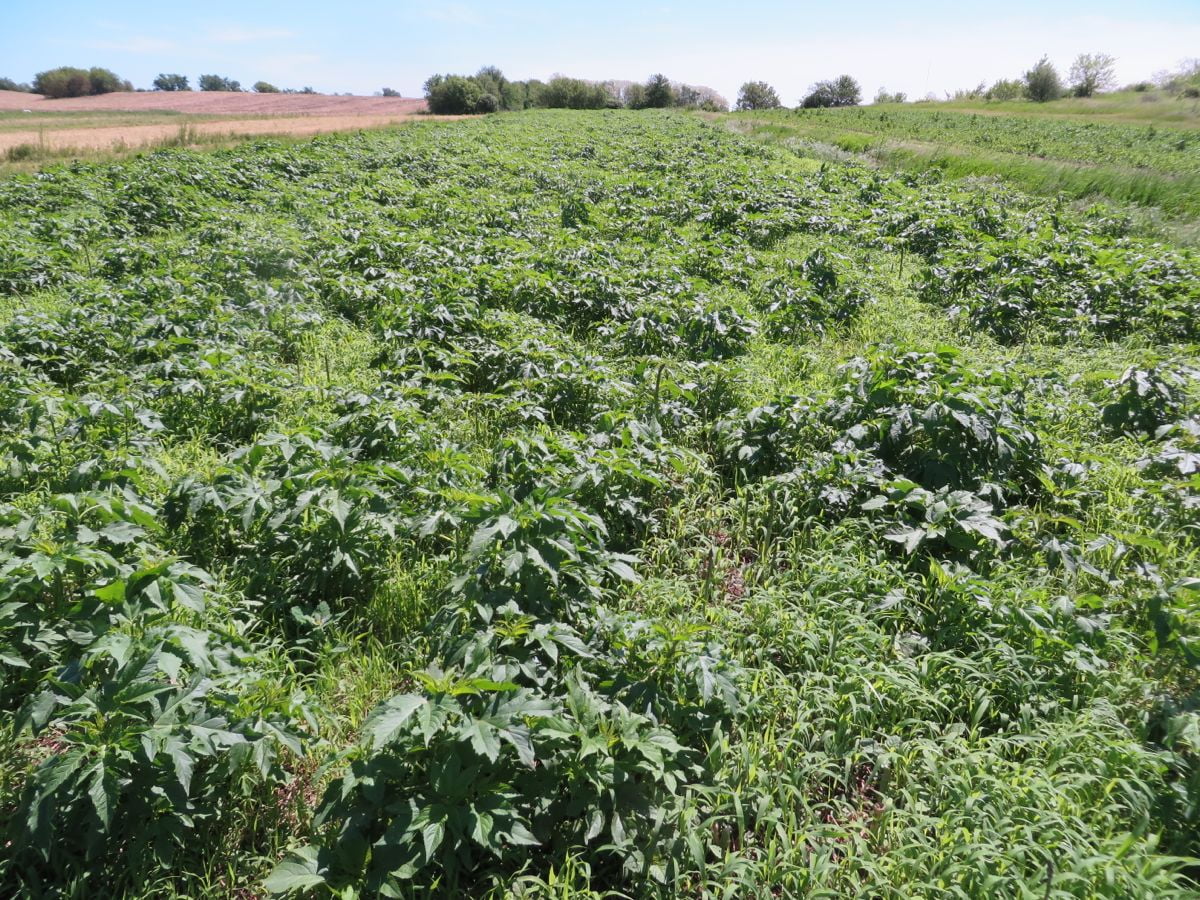
The ragweed overwhelmed the asparagus by late May. If you look closely, you can see a few asparagus spears poking up. We had to do something drastic or harvests would be finished for this half-acre field. Hand-weeding was out of the question; hoeing would damage the asparagus tips growing beneath the surface. Plus, it’s a daunting job to add at a busy time of year.
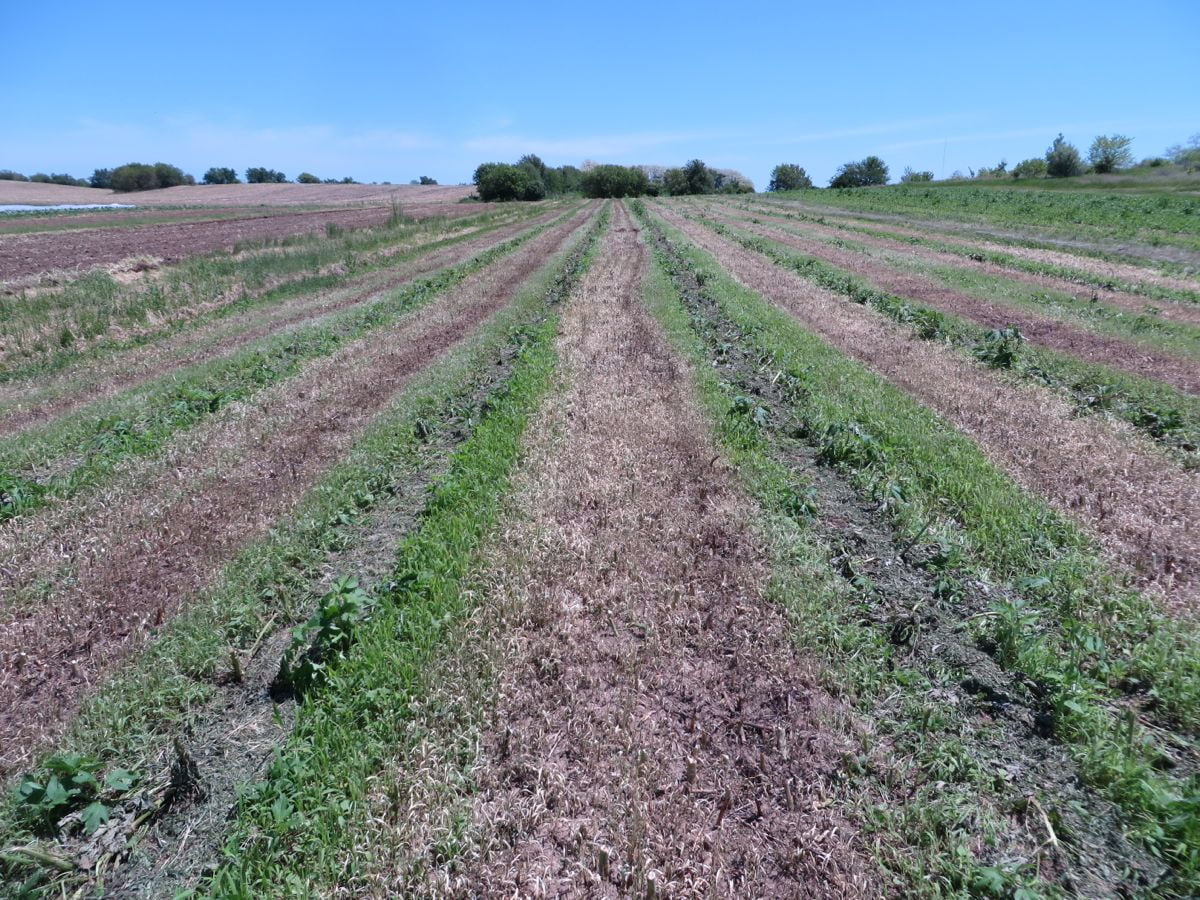
Steve tried something new. He mowed down the weeds, then went over the asparagus beds with his LP-fueled flame weeder to scorch the weeds. We didn’t know if this would work.
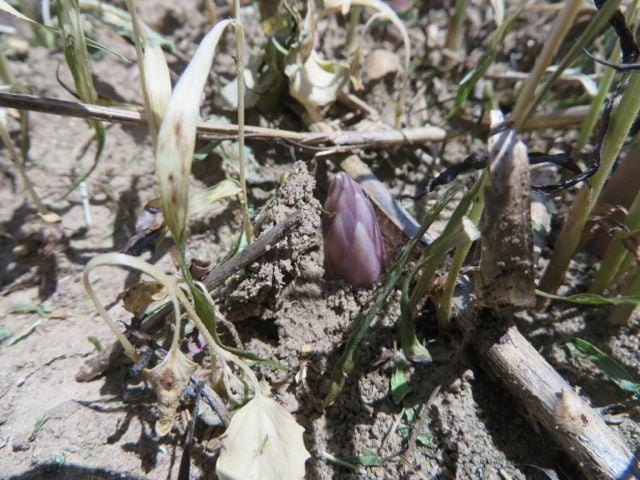
Fresh, undamaged asparagus emerged the next day.
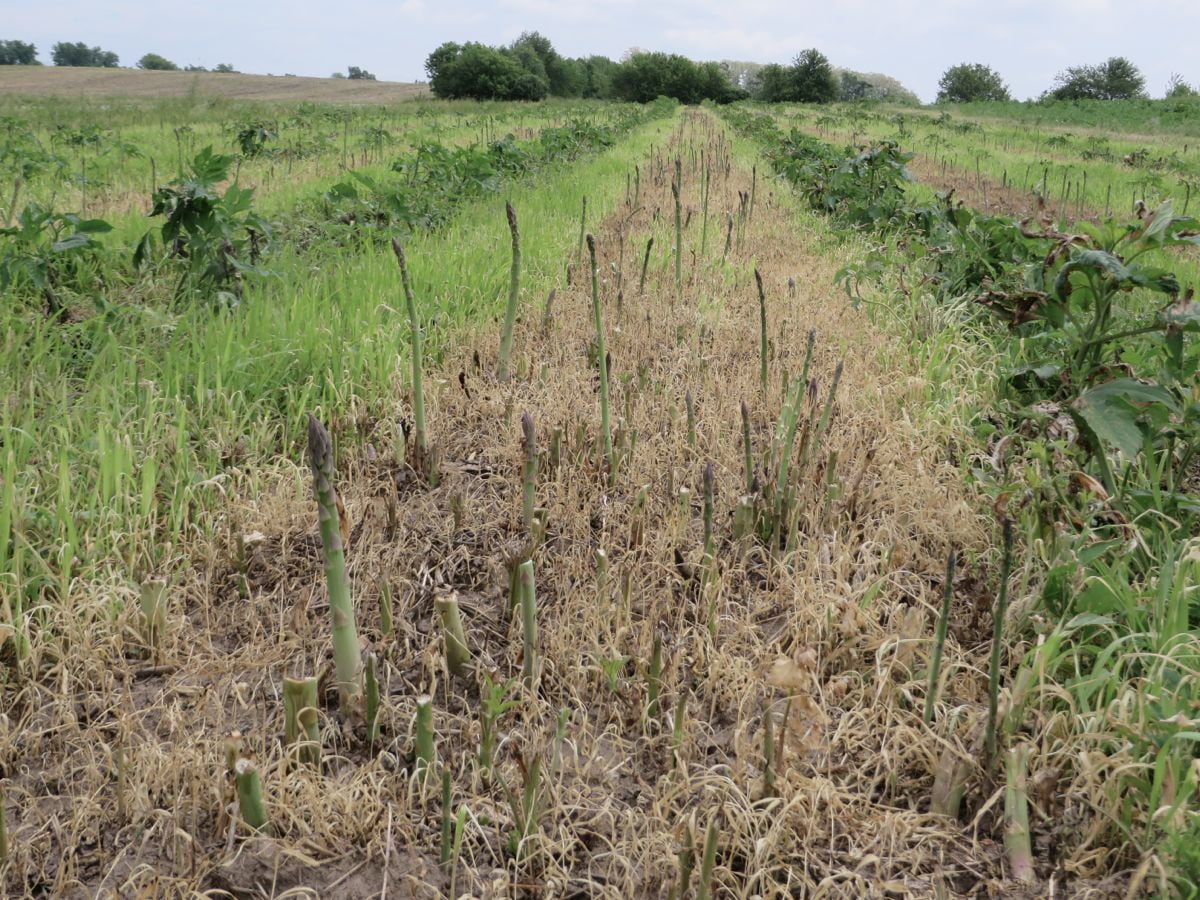
One week later, it was clear the flaming worked. The ragweed in the tractor wheel tracks survived but that’s not a concern. We will till those weeds after our asparagus harvests are finished. Steve’s maneuver let us pick asparagus for you for an extra three weeks!
Veggie List and Veggie Notes (June 11/12, 2015, week #4, green EOW)
Asparagus, 1.25 lb
Spinach, 1 bunch
Green leaf lettuce
Green kale, 1 bunch
Scallions, 1 bunch
Kohlrabi, 1
White salad turnip, 1 big
Cilantro
A few of our Thursday sites will get 1 pint strawberries. We will have berries for everyone next week.
Next week’s box will probably contain strawberries, sugar snap peas, asparagus, spinach, lettuce, scallions, some type of greens and more. Garlic scapes and daikon might be ready next week.
Spinach (bundle of dark green leaves) – This week’s spinach is from a new planting. It’s in perfect condition, which made harvest an easy job for the crew. Good for salads or cooking.
Green kale (bundle of dark green, frilly leaves) – Super nutritious, this first picking of the year is great cooked or used in raw salads like the one from Local Thyme this week.
Kohlrabi (pale green, round vegetable with thick skin) – Crunchy and sweet, kohlrabi is a great addition to salads.
Storage: Kohlrabi bulbs will store for a month in the refrigerator.
Uses: Kohlrabi are good peeled and eaten out of hand, or added to sandwiches. It is good mixed into salads, or prepared as a salad on it’s own. You can grate it, slice it, or cut it into matchsticks. It’s also good cooked. If you have it, the Asparagus to Zucchini cookbook has a long list of kohlrabi suggestions.
White salad turnip (white, round vegetable with thin skin) – Jon calls these our ‘early watermelons”: sweet, succulent and oddly large. Our turnips rarely grow to this size while staying such high quality. We snack on them in the fields, skin and all. Great for salads too.
THIS WEEK’S RECIPES
Comforting Classics
Raw Kale Salad with Pine Nuts and Currants
Kohlrabi Kimchee
Pinto Bean and Salad Turnip “Macos” or Ground Turkey and Salad Turnip “Macos”
Scallion Vinaigrette
Braised Asparagus with Feta and Lemon
Raw Spinach Wraps with Hummus and Vegetable Sticks
Outside the Box Recipes
Kohlrabi and Salad Turnip Wasabi Salad
Quinoa, Spinach and Egg Breakfast Bake
Curried Kohlrabi and Salad Turnip Rice Pilaf
Greek Kale and Spinach Fritters
Scallion Barlotto (Barley Risotto)
Asparagus Gribiche
Kitchen Sink Recipe
This is a recipe that is very flexible — you can add just about any, or all of the veggies in your box.
Kohlrabi, Kale and Salad Turnip Soup with Kidney Beans
Quick and Easy Dinner Idea
Big bang moment
- On: June 03, 2015
 0
0
Steve loves transplanting season, and marvels how quickly a compact mass of seedlings expands to fill our farm. Two wagonloads of tomato seedlings expand into 1.3 acres in the field. Can we continue that expansion for the next 13 billion years? No, probably not.
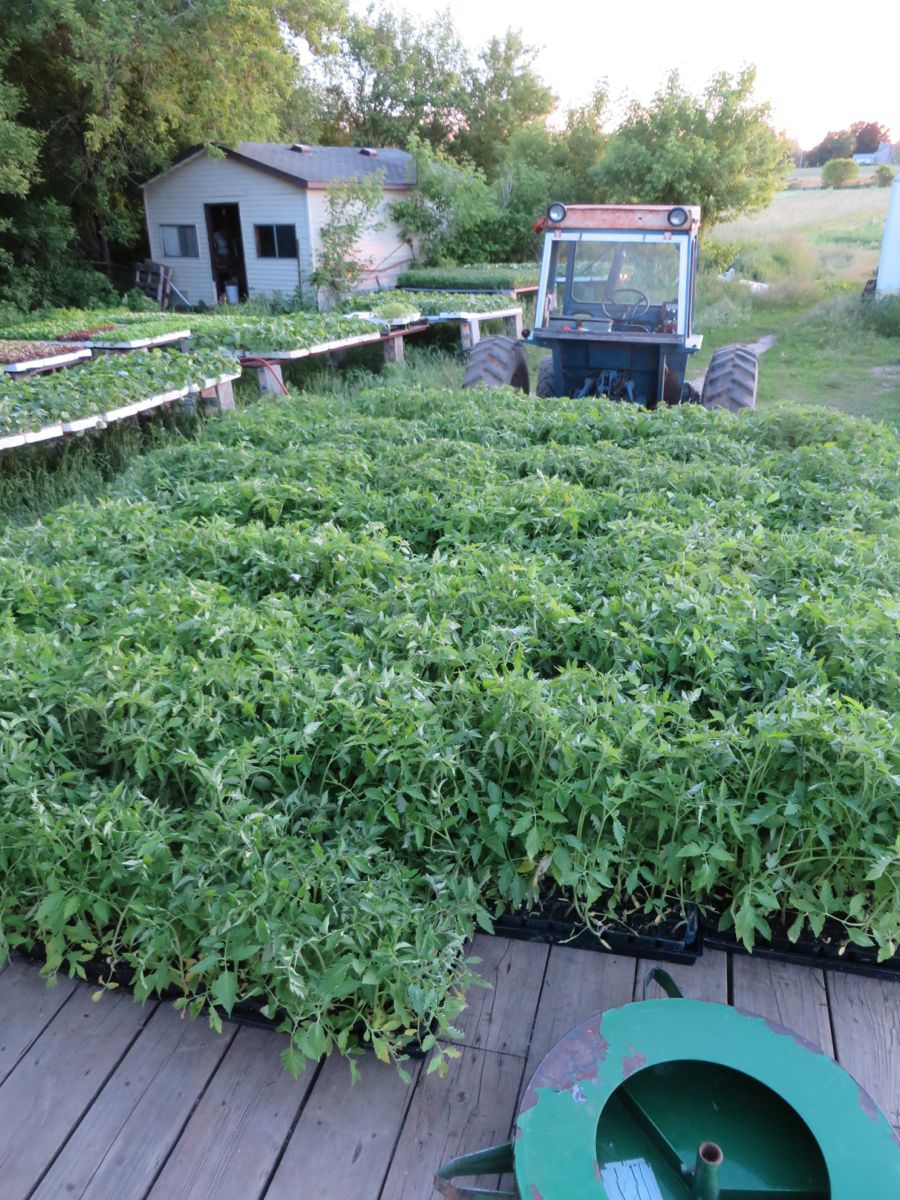
Tomato seedlings await transplanting. The green wheel is for our mechanical transplanter. It digs holes at a regular spacing.

The seedlings on the wagon filled this 1/2 acre field.
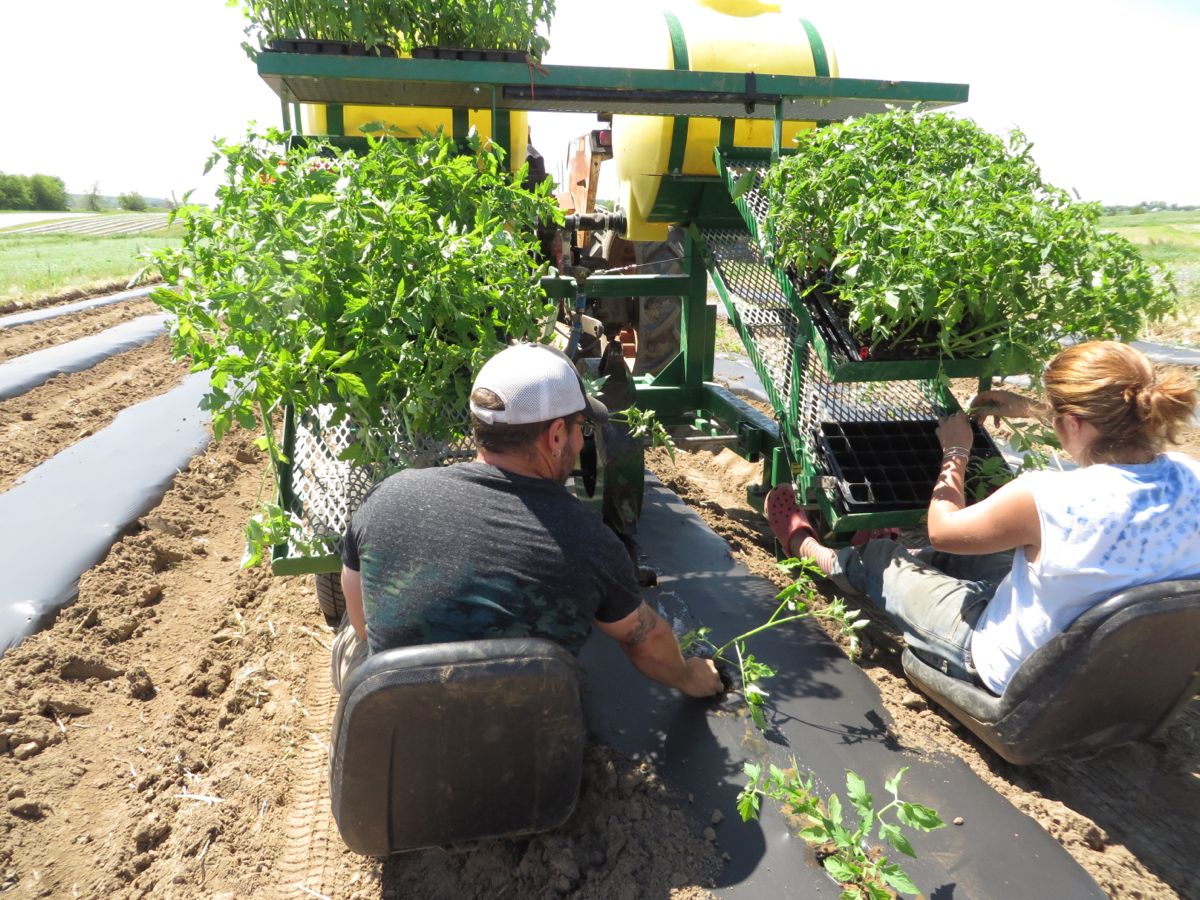
The seedlings go in quickly with our transplanter and crew …

… followed by more people to set the plants in place. The tomato plants are leggy. Our transplanting schedule was thrown off by rainy weather. They will recover but it’s not the best start.
Tweak of the week – Something new and interesting this week.
We strive to make improvements every season. Innovation keeps farming fresh and interesting for us. New this year, we interspersed alyssum seedlings into our early lettuce and bok choy plantings. We hope to control aphids, an insect which has been problematic on these spring vegetables the last few years. Alyssum is an ‘insectary plant’, a host for beneficial insects that prey on crop pests. New research shows that interspersing 1 or 2 alyssum per 50 lettuce seedlings is enough to control aphids as effectively as conventional pesticide sprays. How cool! Sure, the alyssum displaces some harvestable lettuce but is worth the trade-off for higher quality. So far, our lettuce remains clean of aphids this year.
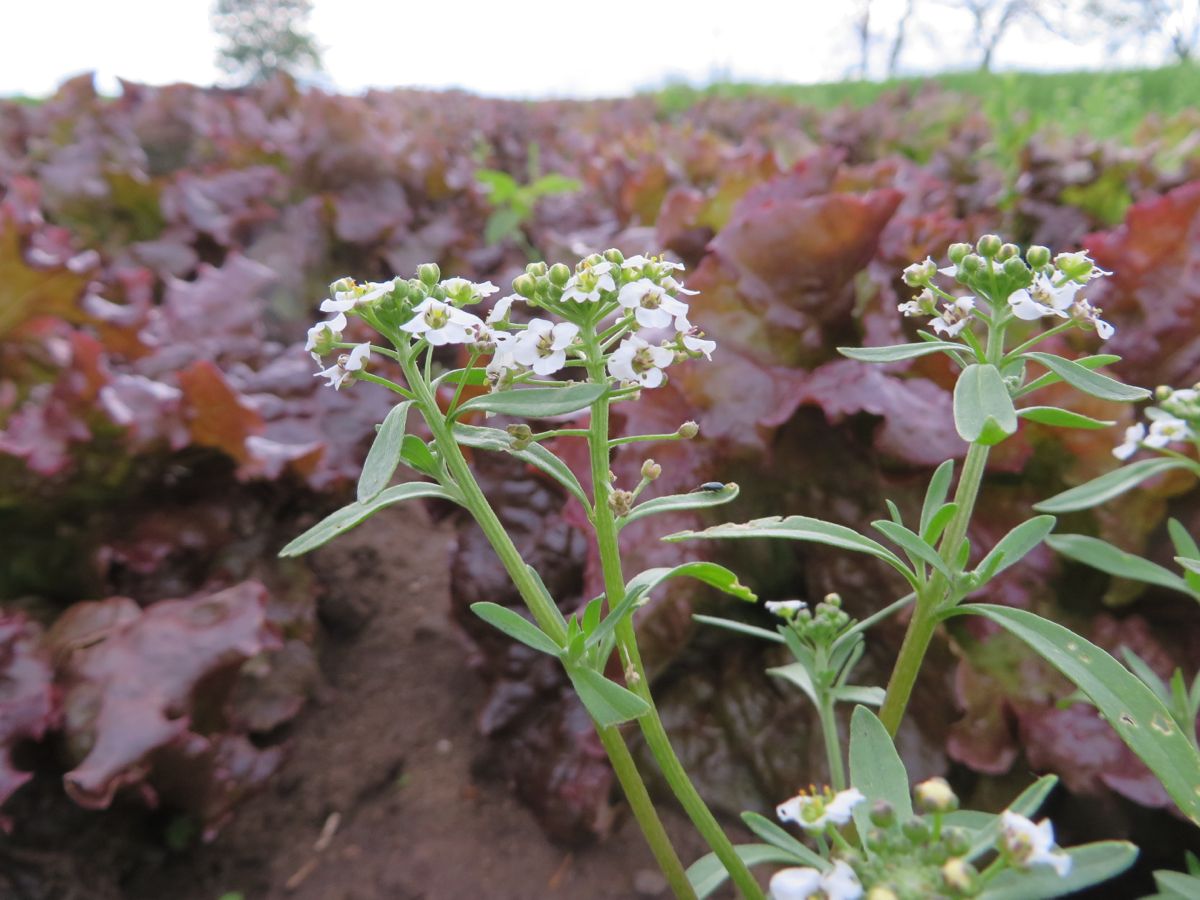
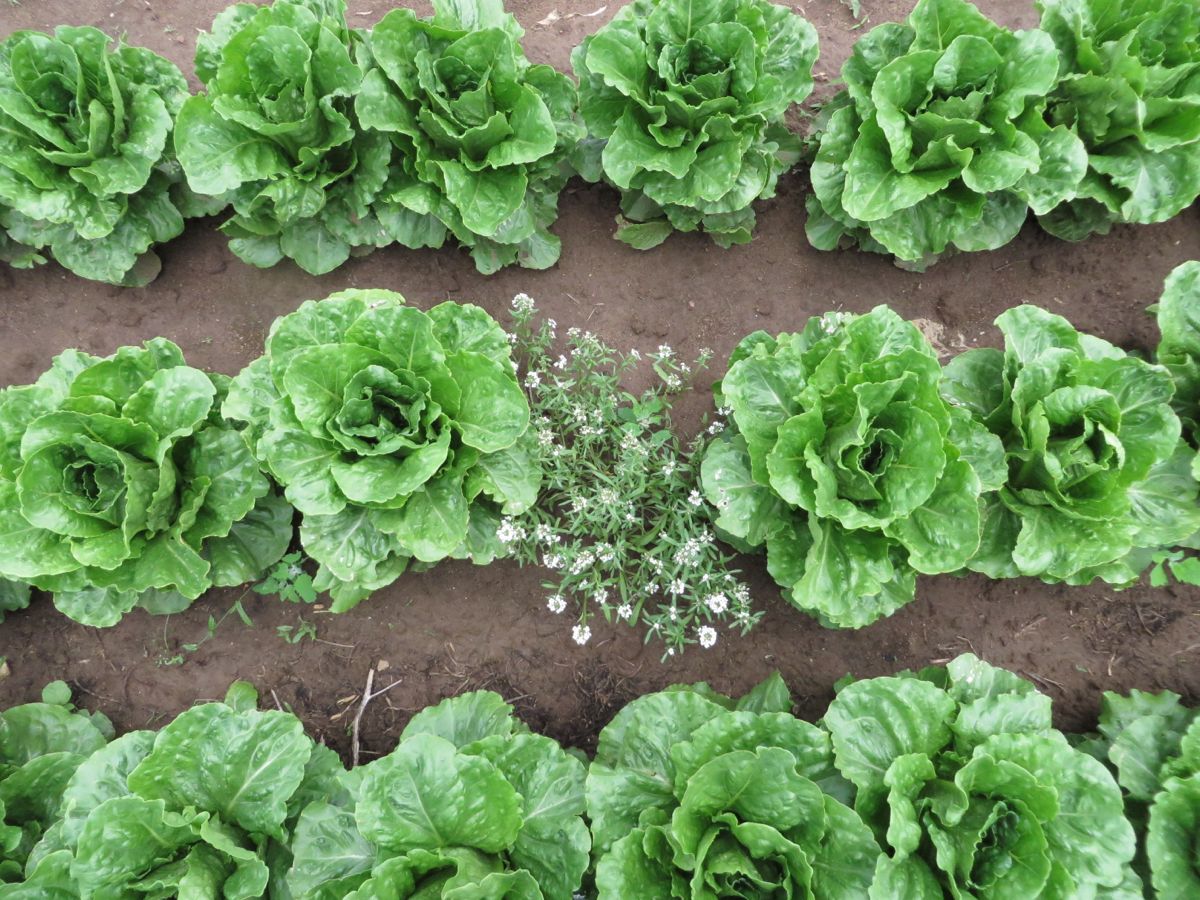
(top) Alyssum flowers with red bibb lettuce in background. (bottom) Alyssum interspersed among Romaine lettuce.
Veggie List and Veggie Notes (6/4/15, week #3, purple EOW)
This is a box of completely green vegetables. I asked Pat Mulvey to focus on recipes for leafy greens this week. They are big and abundant. If there are more greens than you will use promptly, consider freezing your extras. Steam, chop coarsely and freeze. Add the frozen greens later to casseroles and soups. You’ll be glad you have them. We encourage you to wash your produce carefully again this week (especially asparagus, Romaine, escarole and spinach) because of the recent rains.
Asparagus, 1 lb
Escarole
Romaine lettuce
White salad turnips with greens, 1 bunch
Spinach, 1 bunch
Scallions, 1 bunch
Cilantro, 1 bunch
Next week’s box will probably contain asparagus, kale or collards, lettuce, spinach, kohlrabi, scallions, cilantro and (maybe) more.
Escarole (large head of wavy green leaves) – This member of the chicory family can be eaten raw or cooked. Its slightly bitter flavor is a good addition to mixed salads. It is excellent cooked alone or mixed with other greens. It cooks quickly, but not as quickly as spinach. Cover and refrigerate.
Romaine lettuce (tall head of lettuce with crisp leaves) – More sturdy and less fragile than our other spring lettuces. Great for salads.
White salad turnips (white roots with tender greens) – The greens are particularly nice this week. We just started harvesting from a new field so the roots are a bit smaller than last week.
Scallions (bundle of green onions) – These are useful raw or cooked. Thinly-sliced raw scallions can be folded into biscuit dough or sprinkled on top of soups or salads. Terrific garnish for pasta dishes in combination with cilantro. Think pad thai.
Cilantro (bundle of aromatic leaves) – This herb is good in salsa, chutneys and salad dressings, or added to stir-fries. Used in Mexican, Asian and Indian cooking.
RECIPE FROM BETH; Caesar Salad, made safely with cooked egg yolks.
I love Caesar salad but gave it up years ago. Who wants to eat raw eggs? Lo and behold, there are ways to prepare it safely. Food scientist Harold McGee has developed a method that works. Many Caesar salad recipes call for 10 Tbsp. oil, but you can reduce the oil to 6 Tbsp. (total canola + olive) and the dressing still works.
Harold McGee’s method to sterilize egg yolks
Use a clean fork at each step to avoid re-contaminating the cooked yolks.
2 large egg yolks
1 & 1/2 tsp. water
1 tsp. lemon juice
Mix the ingredients in a clear glass bowl and beat together with a fork. Cover the bowl and microwave on high power until the mixture bubbles (about 45 seconds). Uncover and stir with a clean fork. Cover and microwave until it bubbles again (about 20 seconds) and let it bubble 5 to 10 seconds more. Stir again with another clean fork. Let cool. The mixture will be custard-like.
Caesar Salad
2 large eggs yolks, cooked as described above and still in the clear glass bowl
2 – 3 Tbsp. lemon juice
1 tsp. Worchestershire sauce
1 clove garlic, grated
2 tsp. anchovy paste
5 Tbsp. olive oil (or as little as 3 Tbsp.)
5 Tbsp. canola oil (or as little as 3 Tbsp.)
3/4 cup grated Parmesan cheese
black pepper
croutons
1 head Romaine lettuce, cut into 2-inch pieces, washed and carefully dried.
Note: Our Romaine vary in size. Start with half your Romaine, and gradually toss together with the dressing to be sure you have the right amount of lettuce.
1. Add the lemon juice, Worchestershire sauce, garlic and anchovy paste to the cooked egg yolks. Stir together with a fork. Let stand 5 – 10 minutes.
2. Slowly drizzle the canola and olive oils into the mixture while beating with a fork to emulsify. Stir in 1/2 cup Parmesan and black pepper to taste.
3. Mix the dressing with the prepared Romaine and croutons in a large bowl and toss to coat. Taste and add the remaining 1 Tbsp. lemon juice if needed. Sprinkle remaining Parmesan over top. Serve.
LOCAL THYME RECIPES
Comforting Classics
Classic Warm Spinach Salad or Warm Spinach and Shiitake Salad
Steamed Salad Turnip with Greens
Italian Escarole Wedding Soup and Vegetarian Italian Wedding Soup
Southwestern Caesar
Scallion and Cilantro Pancakes
Cilantro Chimichurri with Scallions
Outside the Box Recipes
Green Curry Simmered Veggies
Salad Turnip with Miso Ginger Vinaigrette
Escarole and Apple Salad
Teriyaki Asparagus Romaine Stir Fry
Fried Scallions
Salad with Lime Soy Cilantro Sauce
Kitchen Sink Recipe
This is a recipe that is very flexible — you can add just about any, or all of the veggies in your box. Grill some scallions, romaine and salad turnips and toss them on too!
Grilled Pizza with Wilted Spinach and Shaved Asparagus
Quick and Easy Dinner Idea

